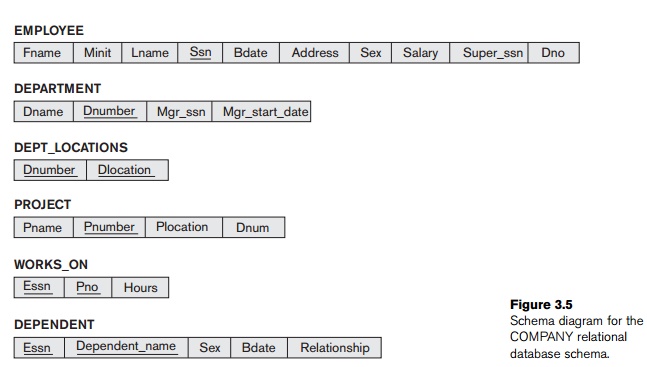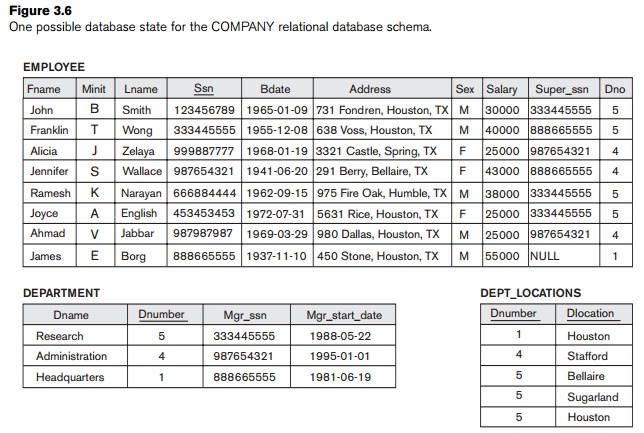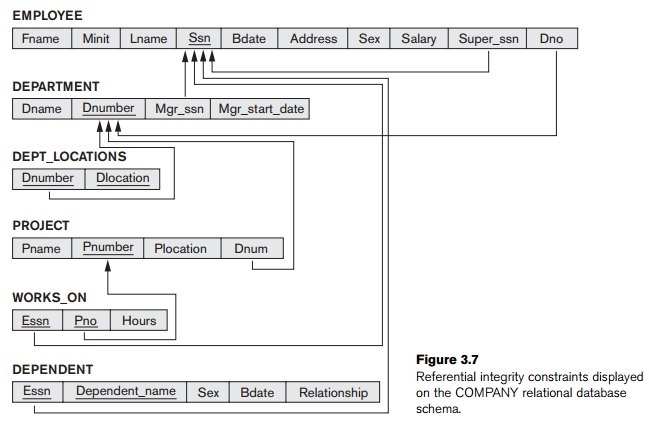Chapter: Fundamentals of Database Systems : The Relational Data Model and SQL : The Relational Data Model and Relational Database Constraints
Relational Model Constraints and Relational Database Schemas
Relational Model Constraints and Relational Database Schemas
So far,
we have discussed the characteristics of single relations. In a relational
data-base, there will typically be many relations, and the tuples in those
relations are usu-ally related in various ways. The state of the whole database
will correspond to the states of all its relations at a particular point in
time. There are generally many restrictions or constraints on the actual values in a database state. These
constraints are derived from the rules in the miniworld that the database
represents, as we dis-cussed in Section 1.6.8.
In this section,
we discuss the various restrictions on data that can be specified on a
relational database in the form of constraints. Constraints on databases can
generally be divided into three main categories:
Constraints that are inherent in the data model. We
call these inherent model-based constraints or implicit constraints.
Constraints
that can be directly expressed in schemas of the data model, typically by
specifying them in the DDL (data definition language, see Section 2.3.1). We
call these schema-based constraints
or explicit constraints.
Constraints that cannot be directly expressed in the schemas of the data model, and
hence must be expressed and enforced by the application pro-grams. We call
these application-based or semantic constraints or business rules.
The
characteristics of relations that we discussed in Section 3.1.2 are the
inherent constraints of the relational model and belong to the first category.
For example, the constraint that a relation cannot have duplicate tuples is an
inherent constraint. The constraints we discuss in this section are of the
second category, namely, constraints that can be expressed in the schema of the
relational model via the DDL. Constraints in the third category are more
general, relate to the meaning as well as behavior of attributes, and are
difficult to express and enforce within the data model, so they are usually
checked within the application programs that perform database updates.
Another
important category of constraints is data
dependencies, which include functional
dependencies and multivalued
dependencies. They are used mainly for
testing the “goodness” of the design of a relational database and are
utilized in a process called normalization,
which is discussed in Chapters 15 and 16.
The
schema-based constraints include domain constraints, key constraints,
constraints on NULLs, entity
integrity constraints, and referential integrity constraints.
1. Domain Constraints
Domain constraints specify that within each tuple, the value of each
attribute A must be an atomic value
from the domain dom(A). We have
already discussed the ways in which domains can be specified in Section 3.1.1.
The data types associated with domains typically include standard numeric data
types for integers (such as short integer, integer, and long integer) and real
numbers (float and double-precision float). Characters, Booleans, fixed-length
strings, and variable-length strings are also available, as are date, time,
timestamp, and money, or other special data types. Other possible domains may
be described by a subrange of values from a data type or as an enumerated data
type in which all possible values are explicitly listed. Rather than describe
these in detail here, we discuss the data types offered by the SQL relational standard
in Section 4.1.
2. Key Constraints and
Constraints on NULL Values
In the
formal relational model, a relation
is defined as a set of tuples. By
definition, all elements of a set are distinct; hence, all tuples in a relation
must also be distinct. This means that no two tuples can have the same
combination of values for all their
attributes. Usually, there are other subsets
of attributes of a relation schema R
with the property that no two tuples in any relation state r of R should have the
same combination of values for these attributes. Suppose that we denote one
such subset of attributes by SK; then for any two distinct tuples t1
and t2 in a relation state
r of R, we have the constraint that:

Any such
set of attributes SK is called a superkey
of the relation schema R. A superkey
SK specifies a uniqueness constraint
that no two distinct tuples in any state r
of R can have the same value for
SK. Every relation has at least one default
superkey—the set of all its attributes. A superkey can have redundant
attributes, however, so a more useful concept is that of a key, which has no redundancy. A key K of a relation
schema R is a superkey of R with the additional property that
removing any attribute A from K leaves a set of attributes K that is not a superkey of R any more. Hence, a key satisfies two
properties:
Two distinct tuples in any state of the relation
cannot have identical values for (all) the attributes in the key. This first
property also applies to a superkey.
It is a minimal
superkey—that is, a superkey from which we cannot remove any attributes and
still have the uniqueness constraint in condition 1 hold. This property is not
required by a superkey.
Whereas
the first property applies to both keys and superkeys, the second property is
required only for keys. Hence, a key is also a superkey but not vice versa.
Consider the STUDENT relation
of Figure 3.1. The attribute set {Ssn} is a
key of STUDENT because no two student tuples
can have the same value for Ssn.8
Any set of attrib-utes that includes Ssn—for
example, {Ssn, Name, Age}—is a superkey. However, the superkey {Ssn, Name, Age} is not a key of STUDENT because removing Name or Age or both from the set still
leaves us with a superkey. In general, any superkey formed from a single
attribute is also a key. A key with multiple attributes must require all its attributes together to have the
uniqueness property.
The value
of a key attribute can be used to identify uniquely each tuple in the
rela-tion. For example, the Ssn value
305-61-2435 identifies uniquely the tuple corresponding to Benjamin Bayer in
the STUDENT relation. Notice that a set of
attributes constituting a key is a property of the relation schema; it is a
constraint that should hold on every
valid relation state of the schema. A key is determined from the mean-ing of
the attributes, and the property is time-invariant:
It must continue to hold when we insert new tuples in the relation. For
example, we cannot and should not designate the Name attribute of the STUDENT relation
in Figure 3.1 as a key because it is possible that two students with identical
names will exist at some point in a valid state.9
In
general, a relation schema may have more than one key. In this case, each of
the keys is called a candidate key.
For example, the CAR relation
in Figure 3.4 has two candidate keys: License_number and Engine_serial_number. It is
common to designate one of the candidate keys as the primary key of the relation. This is the candidate key whose values
are used to identify tuples in the
relation. We use the convention that the attributes that form the primary key
of a relation schema are underlined, as shown in Figure 3.4. Notice that when a
relation schema has several candidate keys,

the choice
of one to become the primary key is somewhat arbitrary; however, it is usually
better to choose a primary key with a single attribute or a small number of
attributes. The other candidate keys are designated as unique keys, and are not underlined.
Another
constraint on attributes specifies whether NULL values
are or are not permitted. For example, if every STUDENT tuple must have a valid, non-NULL value
for the Name attribute, then Name of STUDENT is constrained to be NOT NULL.
3. Relational Databases and Relational Database Schemas
The
definitions and constraints we have discussed so far apply to single relations
and their attributes. A relational database usually contains many relations,
with tuples in relations that are related in various ways. In this section we
define a rela-tional database and a relational database schema.
A relational database schema S is a set of relation schemas S = {R1, R2, ..., Rm}
and a set of integrity constraints
IC. A relational database state DB of S is a set of relation states
DB = {r1, r2, ..., rm} such that each ri
is a state of Ri and such
that the ri relation
states satisfy the integrity constraints specified in IC. Figure 3.5 shows a relational database schema that we call
COMPANY = {EMPLOYEE, DEPARTMENT,
DEPT_LOCATIONS, PROJECT, WORKS_ON, DEPENDENT}. The underlined attributes
represent primary keys. Figure 3.6 shows a relational database state
corresponding to the COMPANY schema.
We will use this schema and database state in this chapter and in Chapters 4
through 6 for developing sample queries in different relational languages. (The
data shown here is expanded and available for loading as a populated database
from the Companion Website for the book, and can be used for the hands-on
project exercises at the end of the chapters.)
When we
refer to a relational database, we implicitly include both its schema and its
current state. A database state that does not obey all the integrity
constraints is

called an
invalid state, and a state that satisfies
all the constraints in the defined set of integrity constraints IC is called a valid state.
In Figure
3.5, the Dnumber
attribute in both DEPARTMENT and DEPT_LOCATIONS stands for the same real-world
concept—the number given to a department. That same concept is called Dno in EMPLOYEE and Dnum in PROJECT. Attributes that represent the
same real-world concept may or may not have identical names in different
relations. Alternatively, attributes that represent different concepts may have
the same name in different relations. For example, we could have used the
attribute name Name for both
Pname of PROJECT and Dname of DEPARTMENT; in this case, we would have two
attributes that share the same name but represent different real-world
concepts—project names and department names.
In some
early versions of the relational model, an assumption was made that the same
real-world concept, when represented by an attribute, would have identical attribute names in all
relations. This creates problems when the same real-world concept is used in
different roles (meanings) in the same relation. For example, the concept of
Social Security number appears twice in the EMPLOYEE relation
of Figure 3.5: once in the role of the employee’s SSN, and once in the role of
the super-visor’s SSN. We are required to give them distinct attribute names—Ssn and Super_ssn, respectively—because they
appear in the same relation and in order to
distinguish
their meaning.
Each
relational DBMS must have a data definition language (DDL) for defining a
relational database schema. Current relational DBMSs are mostly using SQL for
this purpose. We present the SQL DDL in Sections 4.1 and 4.2.


Integrity
constraints are specified on a database schema and are expected to hold on every
valid database state of that schema. In addition to domain, key, and NOT NULL constraints, two other types of
constraints are considered part of the relational model: entity integrity and
referential integrity.
4. Integrity, Referential Integrity, and Foreign Keys
The entity integrity constraint states that
no primary key value can be NULL. This is
because the primary key value is used to identify individual tuples in a
relation. Having NULL values
for the primary key implies that we cannot identify some tuples. For example,
if two or more tuples had NULL for
their primary keys, we may not be able to distinguish them if we try to
reference them from other relations.
Key
constraints and entity integrity constraints are specified on individual
relations. The referential integrity
constraint is specified between two relations and is used to maintain the
consistency among tuples in the two relations. Informally, the referential
integrity constraint states that a tuple in one relation that refers to another
relation must refer to an existing tuple
in that relation. For example, in Figure 3.6, the attribute Dno of EMPLOYEE gives the department number for
which each employee works; hence, its value in every EMPLOYEE tuple must match the Dnumber value of some tuple in the DEPARTMENT relation.
To define
referential integrity more formally, first we define the concept of a foreign key. The conditions for a foreign key, given below, specify a
referential integrity constraint between the two relation schemas R1 and R2. A set of attributes FK in rela-tion schema R1 is a foreign key of R1
that references relation R2 if it satisfies the
following rules:
The attributes in FK have the same domain(s) as the
primary key attributes PK of R2;
the attributes FK are said to reference
or refer to the relation R2.
A value of FK in a tuple t1 of the current state r1(R1)
either occurs as a value of PK for some tuple t2 in the current state r2(R2)
or is NULL. In the former case, we
have t1[FK] = t2[PK], and we say that the
tuple t1 references or refers to the tuple t2.
In this
definition, R1 is called
the referencing relation and R2 is the referenced rela-tion. If these two
conditions hold, a referential integrity
constraint from R1 to R2 is said to hold. In a database of many
relations, there are usually many referential integrity constraints.
To
specify these constraints, first we must have a clear understanding of the
mean-ing or role that each attribute or set of attributes plays in the various
relation schemas of the database. Referential integrity constraints typically
arise from the relationships among the
entities represented by the relation schemas. For example, consider the database shown in Figure
3.6. In the EMPLOYEE
relation, the attribute Dno refers to
the department for which an employee works; hence, we designate Dno to be a foreign key of EMPLOYEE referencing the DEPARTMENT relation. This means that a
value of Dno in any
tuple t1 of the EMPLOYEE relation must match a value of
the
primary key of DEPARTMENT—the Dnumber attribute—in some tuple t2 of the DEPARTMENT relation, or the value of Dno can be
NULL if the employee does not belong to a department or will be
assigned to a department later. For example, in Figure 3.6 the tuple for
employee ‘John Smith’ references the tuple for the ‘Research’ department,
indicating that ‘John Smith’ works for this department.
Notice
that a foreign key can refer to its own
relation. For example, the attribute Super_ssn
in EMPLOYEE refers to the supervisor of an
employee; this is another employee,
represented by a tuple in the EMPLOYEE
relation. Hence, Super_ssn is a
foreign key that references the EMPLOYEE relation
itself. In Figure 3.6 the tuple for employee ‘John Smith’ references the tuple
for employee ‘Franklin Wong,’ indicating that ‘Franklin Wong’ is the supervisor
of ‘John Smith.’
We can diagrammatically display referential
integrity constraints by drawing a directed arc from each foreign key to
the relation it references. For clarity, the arrowhead may point to the primary
key of the referenced relation. Figure 3.7 shows the schema in Figure 3.5 with
the referential integrity constraints displayed in this manner.
All
integrity constraints should be specified on the relational database schema
(i.e., defined as part of its definition) if we want to enforce these
constraints on the data-base states. Hence, the DDL includes provisions for
specifying the various types of constraints so that the DBMS can automatically
enforce them. Most relational DBMSs support key, entity integrity, and
referential integrity constraints. These constraints are specified as a part of
data definition in the DDL.
5. Other Types of
Constraints
The
preceding integrity constraints are included in the data definition language
because they occur in most database applications. However, they do not include
a large class of general constraints, sometimes called semantic integrity constraints, which may have to be specified and
enforced on a relational database. Examples of such constraints are the salary of an employee should not exceed
the salary of the employee’s
supervisor and the maximum number of
hours an employee can work on all projects per week is 56. Such constraints
can be specified and enforced within the application
programs that update the database, or by using a general-purpose constraint specification language.
Mechanisms called triggers and assertions can be used. In SQL, CREATE
ASSERTION and CREATE TRIGGER
statements can be used for this purpose (see Chapter 5). It is more common to
check for these types of constraints within the application programs than to
use constraint specification languages because the latter are sometimes
difficult and complex to use, as we dis-cuss in Section 26.1.
Another
type of constraint is the functional
dependency constraint, which establishes a functional relationship among
two sets of attributes X and Y. This constraint specifies that the
value of X determines a unique value
of Y in all states of a relation; it
is denoted as a functional dependency X
→ Y. We use functional dependencies and other types of dependencies
in Chapters 15 and 16 as tools to analyze the quality of relational designs and
to “normalize” relations to improve their quality.

The types
of constraints we discussed so far may be called state constraints because they define the constraints that a valid state of the database must
satisfy. Another type of constraint, called transition constraints, can be defined to deal with state changes
in the database.11 An example of a transition constraint is: “the
salary of an employee can only increase.” Such constraints are typically
enforced by the application pro-grams or specified using active rules and
triggers, as we discuss in Section 26.1.
Related Topics